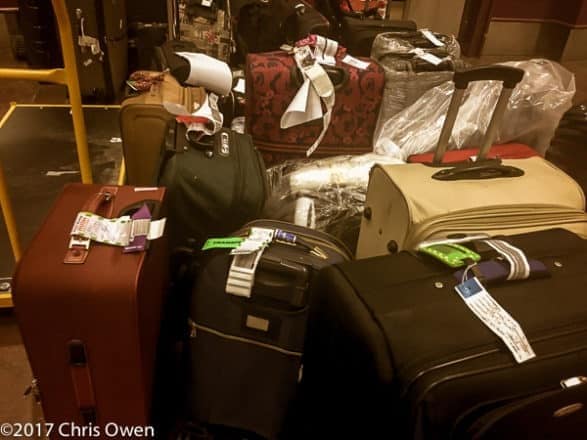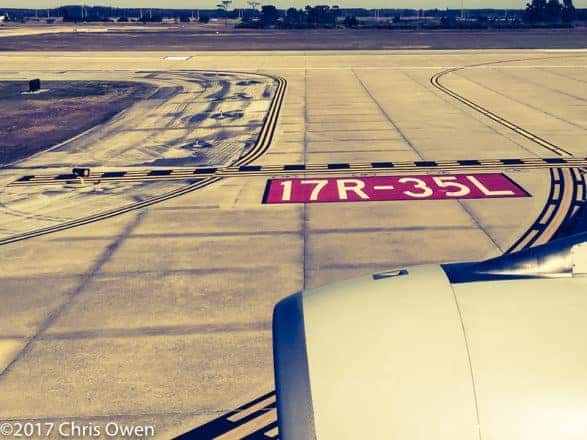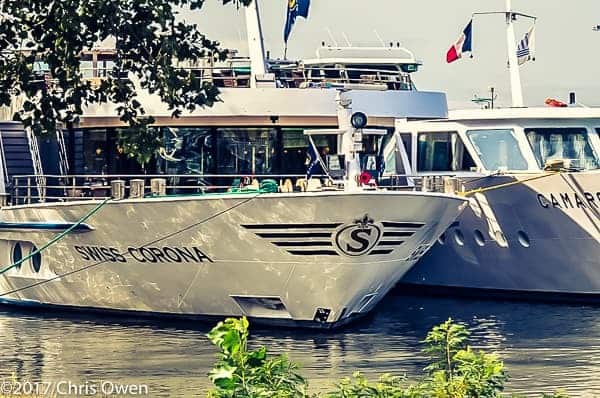Regardless of how we travel, there is a clear correlation between the amount of planning done and success.
Some travelers spend very little time planning and suffer bad results. Run out of gas; the car will not run. Arrive late at the airport; the flight will be gone. Show up at the cruise ship without the correct documentation; no boarding allowed.
There are also travelers who invest too much time in planning. If anything goes wrong for them, the day is ruined. The car had plenty of gas but parking places were hard to find. They got on the plane just fine but could not get past the screaming baby. At the ship, embarkation started later than anticipated, throwing their first day timeline off.
Somewhere in between the two extreme schools of thought about planning there is a happy medium. Just the right amount of planning to insure all the boxes have been checked while allowing for the inevitable unexpected. Travelers accustomed to ocean cruising may very well have their routine down pat. They know what to do, when to do it and everything works out nicely. European river cruising is another story altogether, requiring a different set of skills and a dynamic river cruise planning timeline.
A YEAR OR MORE IN ADVANCE
Hopefully, this is when the European river cruise was booked, for a number reasons. Hopefully, a travel agent who specializes in river cruises and has personally sailed on a number of them was used to make the booking. This is critical for first-time river cruise travelers, especially if their international travel is not frequent.
- Best Pricing and availability– Somewhat like ocean cruises, as ships fill prices go up. A far longer average booking window makes availability more of a concern
- Best Value- discounted airfare, land packages, amenities and/or other perks
- Study time– Odds are that European river cruise will take us amazing places we have dreamed of seeing. Once there, travelers enjoy learning more about those places and often say “I wish I had spent more time learning before arriving.”
- Luggage- Those who do not travel often or have never traveled internationally can start thinking about luggage they will bring on their river cruise. While your air schedule will not be ready at this point, get an idea of what the current luggage regulations are on a variety of likely airlines. Defining your luggage needs at this point allows plenty of time to buy what is needed at the best price. The best time of the year to buy luggage? March.
- Visit Message Boards Mining For Facts- Cruise Critic message boards are a fountain of knowledge if we know what to look for. We can get an idea of which airline will be used by your river cruise line via a variety of social sources with a clear goal. For this purpose, ignore the ratings, reviews and personal thoughts expressed by others. Look for the mention of specific airlines. Major river cruise lines contract huge blocks of seats on flights from North America to Europe embarkation ports. Those airlines do not often change.
- Passport Expiration Date- Passports are required to be valid for at least six months after the completion of travel. Processing time for a new passport or renewal time for an existing one varies. The U.S. Department of State has a time estimator, occasionally updated to reflect actual anticipated processing times. As I write this, new passports take approximately 6 weeks from the time of application, including mailing time. Expedited service is available for a fee and brings a new passport in 2 to 3 weeks, door to door. Planning in advance there is no reason to pay additional fees for expedited service.
- Visas- If you are traveling to China, Russia, Egypt, Jordan or Southeast Asia, you will need a visa. A Visa service can take care of this for you.
- Cell Phone Service- European cruise booked a year or more in advance brings time to include that information in other buying decisions as well. Cell phone service that does not include international data, text and talk will limit what can be shared with friends back home as well as just normal communications. The idea of that may appeal to you. If not there are service providers who are better at international travel than others. It may be time to switch, considering this new requirement.
- Seriously Consider Pre-Cruise Plans- Odds are your European river cruise will require at least two flights getting there and getting back. That makes for a long day before and after the cruise itself. For example, we live in Orlando where there are few direct flights to Europe. Odds are we will connect at a major airline hub in the United States before the long flight across the pond. We can make that an easier process by breaking that series of flights into two days. Same on the return.
- Recommended Reading and Viewing- Now is the time to buy or find sources for recommended reading before your European river cruise. Viking River Cruises, for example, has a rich library of video specific to itineraries. Sailing on their Grand European Tour in September, we’re already considering their video and reading list.
Air Plan- Now we get somewhat serious about air travel plans. The cruise line, however, may not be serious about those plans at this point. If the price of your European river cruise included air, not all is created equal. A large river cruise line will have substantially more buying power than smaller lines. At this point, we should have a proposed air schedule which may or may not be acceptable. Also, from this point on we assume that air was booked through the river cruise line and not independently.
Critical items to look for:
- Amount of time between connections- At the very minimum, an hour or so. I like at least two hours and prefer three. That leaves time to physically make it from one plane to another and allows for flight delays all the way around.
- Preferred Airline- Flight schedules are usually sent no earlier than 75 days prior to departure which allows the cruise line to negotiate the best deals and flights for their guests. Individual travelers who prefer one airline over another will be happy if their airline is chosen. They can also pay a deviation fee to choose a specific airline. If airfare was included in the price of the cruise and a preferred airline or flight schedule costs more, you will pay that difference.
- Deviation Fee- Some travelers and/or agents will pay a deviation fee up front, sure they will want to modify some aspect of the reservation. I suggest waiting to see what the cruise line proposes. The cruise line designed air schedule may be just fine. After all, they really do want us to get there safely and on time.
- Seat Selection- When the cruise is booked with airfare, we know the price of that airfare. We find out seating arrangements when that air is ticketed (paid for) by the cruise line, which can occur months after the booking is made. When air is ticketed is important because that’s when seating can be selected. We may have a booking code (GH6X7T, for example) but until the air is ticketed we can’t select seats or if we can, that selection may not stick.
- Air Plan- When you receive your schedule, it may or may not reflect a seating assignment. Airline policies concerning specific seat requests, random seat assignments, and check-in-only seat requests vary widely. Contact your airline to find out whether you have seat assignments and what the policy is regarding obtaining or changing seats.
- Verify Your Approved Documentation- By now, you should have locked down the documentation needed for travel.
- Consider Travel Safety- Now is a good time to become familiar with any U.S. Department of State Travel Alerts and Warnings applicable to where you will go.
- Air Plan Now is time to seriously consider air travel plans. If the schedule is acceptable, great, you’re done for now. If changes need to be made they need to happen before the cruise line finalizes air plans. Once that is done, future changes will incur a change fee. If the new flights cost more, the traveler will be required to pay the difference too. Airlines sometimes change their schedules or change aircraft, resulting in a different configuration from the one in place when your reservation was made. Therefore, air seats are not guaranteed and may be changed by the airline or the cruise line.
- TSA Requirements- Check with individual airlines for their luggage and boarding policies. Also check with the TSA on what items they will (and will not) allow through security screening. This may have changed since you last traveled.
- Airline Requirements- Important also: Check airline luggage policies both ways. Just because your airline on the way to Europe allowed two pieces of checked luggage conforming to a certain weight and size requirement does NOT mean that airline partner used for the return flight will.
- Air Plan- The air schedule should be solidly locked down at this point. Changes now may not be possible or may be quite costly. Again check seating. Also recommended: If the flight across the pond is a long, overnight flight, consider ordering a special meal. That gets served first, allowing you to sleep longer. Better idea if the flight leaves late and you do not normally eat late, skip the food altogether.
- Partner Airlines- Your flight may be a code-share among partner airlines. Make sure you look carefully at your flight information to determine your air carrier. This will assist you in finding correct departure gate information and help you understand which airline’s luggage restrictions and other rules will apply.
- Weather- start watching advance weather forecasts paying special attention to temperature trends. This information will be needed later, when final packing for the trip.
- Cruise Documents Should Be There– About 30 days in advance of sailing is when most river cruise lines send travel documents to passengers. They wait until this point so they can include the finalized air schedule, your final itinerary details and passenger ticket contracts. Review all items carefully to make sure everything is correct and that you are clear on your departure date and time.
- Air Plan- Check seating again. Actually, check seating every time you look at an airline reservation to be sure a) your selection is still a good one and b) other options have not opened up that may be more beneficial to you. Seats that appeared to be occupied before may be available now. This is probably about the last date a special meal can be ordered as well.
- Practice pack- take a day to pack as though travel is tomorrow. Packing clothes dedicated to travel is helpful but not as helpful as including everything you will bring on the trip.
- Order Currency- It is a good idea to have some local currency on hand before arrival in Europe. Your local bank can order that for you at a far more favorable exchange rate than that of a currency exchange at the airport. Once in Europe, the best and most secure way to get cash is through a bank atm machine.
- Air Plan- You know the drill by now: check seat locations and consider other options that may be available now.
- Air Plan- It is always a good idea to confirm your flights a day or two ahead of time. Also in many cases you can now check in and obtain your boarding passes online. You might also be able to make arrangements to have your return flights confirmed for you by email or directly to your mobile phone. Still, I recommend printing boarding passes anyway.
- Pre-packing- Luggage designated, begin packing by arranging everything that will go in the luggage on a bed or floor area. Capture an image of those items that will be helpful if luggage is lost and a claim is to be filed at a later date.
- Review Documents- Take another look at documents provided by the cruise line. At three days to travel, the pressure is on. An item that was overlooked before may jump off the page as something that can be handled now. An updated emergency contact list is a good idea, not so much as the airline or cruise line is concerned but to remind that emergency contact person that they may be called upon in the now near future. Is their contact information still accurate?
- You are packed. Before leaving for the airport, capture an image of your luggage and bring it with you on a smartphone or camera. You don’t want to be fumbling around looking for that photo when luggage is lost and your world has been turned upside down anyway.
- Backup important computer files. If needed while traveling, putting them on a USB drive is not a bad idea.
- At the Airport- Arrive at least two hours before your flights. If the first flight is domestic, boarding will begin about 30 minutes in advance of departure. International flights begin boarding about an hour before departure.
- Enjoy The Flights And Have A Great Cruise- You did your homework, followed along on the history of your booking and have put yourself in the best possible position to enjoy the experience. Do that.
As much planning as we might do, there is always a bit of apprehension when traveling to Europe for a river cruise. By following good planning practices, the information provided here as well as that of your travel agent and the cruise line, odds are your experience will be wonderful. Now, relax and enjoy travel. Keep in mind that variations of what we anticipate are inevitable. Enjoy those as well.
The title of this post is Dynamic River Cruise Planning Timeline. The ‘Dynamic’ part comes in the flexibility it affords as well as one final thought: packing lists, timelines and organizational tools of that sort are best utilized when updated frequently. Better yet, customize those tools by considering your personal interests. Make what you want out of travel as important as critical must-do items for the best overall experience.










Comments are closed.